
With warmer weather comes the opportunity to get outside. Whether your outdoor adventures include physical sports or mental sports, reading a good book under a tree, in your backyard, or while resting on a hike or in a canoe is a great way to spend a spring day. This issue of ChildrensLit Now invites you to explore both new and old books. We also highlight another publisher meeting a vital niche- families. Happy Spring!
Shelley Oakley
Director, Children's Literature
Subscribe to ChildrensLit Now Newsletter
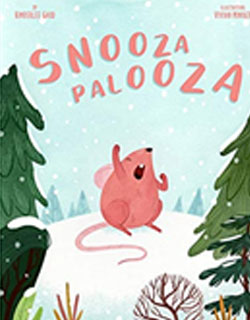
A snoozapalooza all day and all night is the playful refrain throughout this story, as ten sleepy animals get settled in for a cozy winter nap. With lyrical, rhyming text, this sweet bedtime story progresses at a steady pace as it introduces young readers to the concept of size and the related adjectives. The story begins with a single mouse that creates a tiny heap and leads to a bear that squeezes into the now massive heap, which has grown with each successive animal. In addition to learning about size, readers will also be able to practice their counting skills, as they add animals from one to ten, thus making the story not only fun and enjoyable but also educational. Observant readers may notice that some adjectives and verbs are printed in italics or bold type, drawing attention to the uniqueness of language and opening the door for further discussion and teaching opportunities. Use with younger children as a simple introduction to the concept of hibernation or with slightly older children as part of an English lesson on descriptive language. No matter how this book is introduced, it is sure to be a favorite.
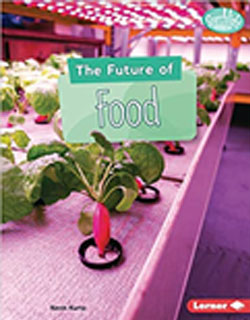
For readers who want to think beyond the next meal, author Kurtz provides a look at the future in four chapters: “Food Challenges,” “Let’s Talk about Meat,” “Farming More With Less,” and “A Healthier Future.” Stating eye-popping facts (e.g., the average American eats about 1 ton of food a year) and exploring new research projects (e.g., a floating dairy farm in Rotterdam harbor), he deftly outlines serious problems of the food chain, specifically a growing population and a decreasing amount of new arable soil for farming. He also discusses the environmental impact of industrial farming, from plants that require pesticides to animals that produce greenhouse gases. Raising many questions, Kurtz suggests ways in which food production could be streamlined and perhaps even made healthier, through genetic testing, eating “new to you” foods such as algae and crickets, and creating diets based on an individual’s personal requirements. Maybe the future will even involve 3-D-printed foods. Each page has bright clear photographs to complement the text, as well as pull-out boxes to support the concepts introduced and discussed. This book is a wonderful resource for discussion and creative thinking. Recommended for elementary school libraries.
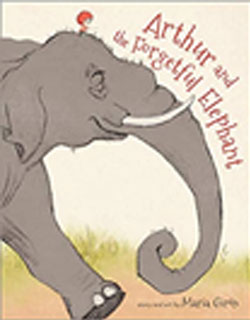
This unusual adventure begins with a rain that’s not really rain at all. On a sunny day, a child named Arthur is surprised by the droplets around him. Gazing up, he realizes there is a crying elephant standing nearby. The sobbing elephant can’t remember his own name or where he is from. Arthur feels sympathetic, understanding that the poor animal must be feeling scared and lonely. So, he tries to cheer the elephant up. He rides on top of the elephant’s back and then slides down his trunk into a river. Then, he sees his friends drawing pictures. Soon, the children are coloring the elephant with beautiful pastel shades. They play until the sun sets when the elephant wants to return home. Meeting Arthur’s family, the elephant starts to think of his own loved ones. Where are they, and what can he do to return to them? Readers will cheer at the ultimate reunion when the elephant’s loving family finds him. They are excited to discover their lost son, now covered with beautiful colors. Arthur and the elephant promise to play together again the next day. In this delightful story, Maria Giron takes readers on a wonderful adventure through an elephant's world. Children will enjoy the amazing illustrations that bring this story to life upon the tapestry of the page.

A seemingly normal day for Pig, Cow, Sheep, Dog, and Raccoon changes when a piercing screech bursts from the barn. Hen is frantic as she races out of the structure in her rabbit slippers. Her precious egg is missing! The animals concur that this dire situation calls for the help of Inspector Billiam Van Hoof. According to his advertisement, posted conveniently on a nearby tree, he is the world’s best goat detective. This mystery, told in a graphic novel format, has many comical moments as the inspector tries to solve the crime. The bumbling Van Hoof seems to fumble along the way. Some children may chuckle over the humor in this light mystery, as the animals help Hen and the inspector locate the egg by examining the clues. Some details, such as the cow’s spotted clothing or the inspector’s gnawed notebook, will start a few laughs. Dumais is the translator of the original French version of her story. Readers who enjoy the graphic novel format are likely to be pleased with this unique tale.
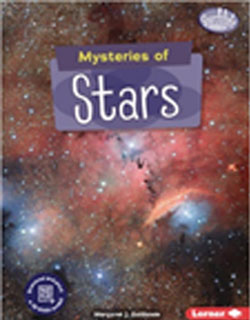
Although stars are some of the most majestic and mysterious entities in the whole of space, their distance and extreme heat make their study hard. This book provides an in-depth introduction to many of the facets of solar exploration for elementary school students. Readers will learn that stars are giant balls of swirling gases, ranging in size and temperature, found in clusters or on their own. In four distinct chapters, this nonfiction book for older elementary school-aged readers will provide a breadth of information about this fascinating subject. The life cycle of a star can be filled with drama, especially at the end when very large stars can become supernovas. Light from stars takes time to travel across the universe, sometimes coming from stars that have died long ago. For centuries, humans have been inspired by the stars that illuminate the night sky, celebrating these celestial orbs in story and ceremony. As scientists learn more about stars and how they function, humans learn more about the nature of the universe and how its independent elements are interconnected. This book is written with middle-length sentences and large blocks on text; ample, full-color visuals are included to increase accessibility and comprehension. Each picture includes a helpful caption with more information about the pictured subject. Historical asides explain to readers how the study of stars has evolved over time. Readers with access to a 3D printer can follow a link provided in the book to create their own replica of the Chandra X-Ray Observatory. Includes a glossary, an index, and a list of resources for further learning. This is an informative and fascinating addition to elementary school nonfiction libraries. Recommended for students in grades 3 through 5.

Familius, founded in 2012, began with a mission to help families be happy. This mission is executed by publishing books for the entire family, from the youngest to the oldest. Each of the books published by Familius falls under one or more of Familius’ 10 Habits of Happy Families: eat together, give together, heal together, laugh together, learn together, love together, play together, read together, talk together, and work together. That’s why it’s not surprising to find a picture book, a book about courageous people around the world, and a book about co-parenting for divorced dads from this publisher. Recently, Christopher Robbins, CEO and co-founder, spoke to us about Familius and how it presents a unique opportunity for creators who want to be a part of this great endeavor. Who doesn’t want to help bring about family happiness!
Tell us about Familius’ place in the world of children’s publishing.
Christopher: Familius focuses on creating beautiful, artistic children’s books that align with our mission to help families be happy. We work to not focus on a title’s commercial value but on its artistic value and its ability to help a family in some way. We believe if we do that and position the book for a defined market, the book will succeed.
How many books does Familius acquire each year, and what is the process?
Christopher: Familius publishes on average 60 books a year, and acquisitions average the same number as we work to acquire two years out. Submissions are sent to bookideas@familius.com, and those submissions that include competitive analysis, as well as a strong author platform, are appreciated. Familius first looks to see if the book aligns with our mission and company values and then explores the market potential and author platform to complement our own work in marketing and sales. As Familius receives thousands of submissions annually, we only respond to those submissions for which we are considering acquisition.
In your opinion, what advantages do small publishing houses provide an author or illustrator?
Christopher: I can’t speak for other houses, but Familius, as a boutique publisher, encourages author and illustrator collaboration with the company. They become part of the overall development team as we work to create the best book possible. Further, those responsible for company decisions are on the frontlines working to help the company be good stewards of an author and illustrator’s content.
What hopes do you have for the future of children’s publishing?
Christopher: Familius hopes that children’s publishing can lead out in helping children embrace a diverse and inclusive world. Rather than look at people as others, we hope that children’s books help educate children and parents to the tremendous possibilities of learning from others and expanding our lives with additional experiences. We also hope that children’s publishing continues to take advantage of technology advances to provide more and more mediums for book discoverability and reader experiences.
Ezra Jack Keats Award
This month marked the 35th anniversary of the Ezra Jack Keats Award, with winners announced on March 9, 2021. The Ezra Jack Keats Award was created to advance Ezra Jack Keats’ legacy by honoring those who create exceptional books reflecting our world’s diverse population and the childhood experience. Since June 2020, the Ezra Jack Keats Foundation has made available in-person and virtual activities and ideas to celebrate this important award. The celebration continues with events like
More information about these events can be found on the Ezra Jack Keats Foundation website at https://www.ezra-jack-keats.org/award-35th-anniversary/.
While we celebrate and congratulate this year’s Ezra Jack Keats winners and honorees, we have chosen to highlight some past Ezra Jack Keats award winners and honorees. Just like The Snowy Day, these specific titles are timeless and highlight experiences and emotions we may all share. Does your library have these past winners in its collection, just as it may have previous Newbery, Caldecott, and Coretta Scott King award winners? If not, we encourage them to be added. Including past award winners from the Ezra Jack Keats award will only strengthen your library’s commitment to inclusion for all.
2014 Winner
Illustrator Christian Robinson for Rain!
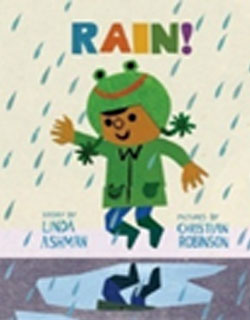
As an old man grumbles his way through a rainy morning, spreading gloom, his neighbor, a young child, spreads cheer while hopping through puddles in frog-themed rainwear.
2004 Winner
Writer Jeron Ashford Frame for Yesterday I Had the Blues
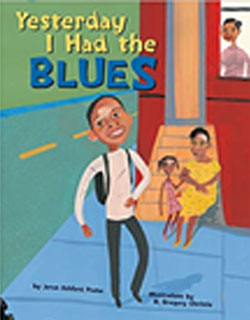
A young boy ponders a variety of emotions and how different members of his family experience them, from his own blues to his father's grays and his grandmother's yellows.
1991 Winner
Writer Angela Johnson for Tell Me a Story, Mama
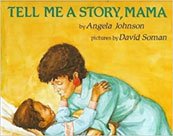
Mama's memories of her own childhood have been told to her daughter so often that the girl has made them her own bedtime litany; she tells her mother the stories, and her mother reassures her that she has the story right.
1987 Winner
Writer Juanita Havill for Jamaica’s Find
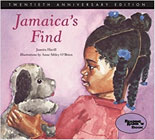
Jamaica finds a stuffed dog at the playground and, after taking him home without trying to find the owner discovers her conscience as well.
★ Did you know that ChildrensLit reviews Spanish/English bilingual books? If you are a publisher who has published Spanish/English bilingual books in the last year, contact shelley.oakley@childrenslit.com to get your new books reviewed.